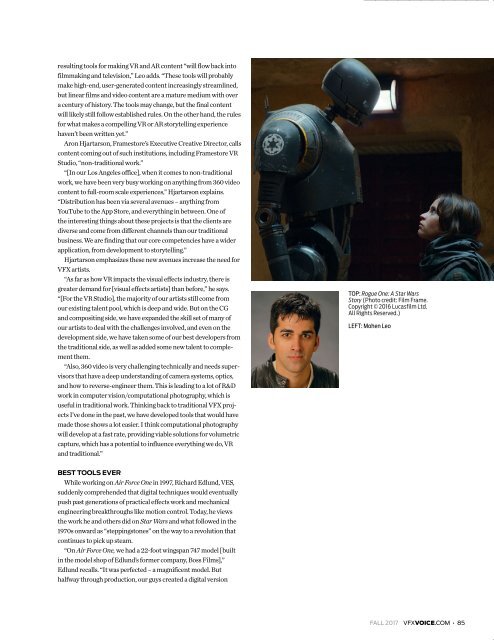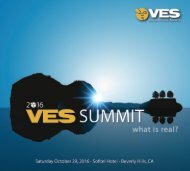Create successful ePaper yourself
Turn your PDF publications into a flip-book with our unique Google optimized e-Paper software.
esulting tools for making VR and AR content “will flow back into<br />
filmmaking and television,” Leo adds. “These tools will probably<br />
make high-end, user-generated content increasingly streamlined,<br />
but linear films and video content are a mature medium with over<br />
a century of history. The tools may change, but the final content<br />
will likely still follow established rules. On the other hand, the rules<br />
for what makes a compelling VR or AR storytelling experience<br />
haven’t been written yet.”<br />
Aron Hjartarson, Framestore’s Executive Creative Director, calls<br />
content coming out of such institutions, including Framestore VR<br />
Studio, “non-traditional work.”<br />
“[In our Los Angeles office], when it comes to non-traditional<br />
work, we have been very busy working on anything from 360 video<br />
content to full-room scale experiences,” Hjartarson explains.<br />
“Distribution has been via several avenues – anything from<br />
YouTube to the App Store, and everything in between. One of<br />
the interesting things about these projects is that the clients are<br />
diverse and come from different channels than our traditional<br />
business. We are finding that our core competencies have a wider<br />
application, from development to storytelling.”<br />
Hjartarson emphasizes these new avenues increase the need for<br />
<strong>VFX</strong> artists.<br />
“As far as how VR impacts the visual effects industry, there is<br />
greater demand for [visual effects artists] than before,” he says.<br />
“[For the VR Studio], the majority of our artists still come from<br />
our existing talent pool, which is deep and wide. But on the CG<br />
and compositing side, we have expanded the skill set of many of<br />
our artists to deal with the challenges involved, and even on the<br />
development side, we have taken some of our best developers from<br />
the traditional side, as well as added some new talent to complement<br />
them.<br />
“Also, 360 video is very challenging technically and needs supervisors<br />
that have a deep understanding of camera systems, optics,<br />
and how to reverse-engineer them. This is leading to a lot of R&D<br />
work in computer vision/computational photography, which is<br />
useful in traditional work. Thinking back to traditional <strong>VFX</strong> projects<br />
I’ve done in the past, we have developed tools that would have<br />
made those shows a lot easier. I think computational photography<br />
will develop at a fast rate, providing viable solutions for volumetric<br />
capture, which has a potential to influence everything we do, VR<br />
and traditional.”<br />
TOP: Rogue One: A Star Wars<br />
Story (Photo credit: Film Frame.<br />
Copyright © 2016 Lucasfilm Ltd.<br />
All Rights Reserved.)<br />
LEFT: Mohen Leo<br />
BEST TOOLS EVER<br />
While working on Air Force One in 1997, Richard Edlund, VES,<br />
suddenly comprehended that digital techniques would eventually<br />
push past generations of practical effects work and mechanical<br />
engineering breakthroughs like motion control. Today, he views<br />
the work he and others did on Star Wars and what followed in the<br />
1970s onward as “steppingstones” on the way to a revolution that<br />
continues to pick up steam.<br />
“On Air Force One, we had a 22-foot wingspan 747 model [built<br />
in the model shop of Edlund’s former company, Boss Films],”<br />
Edlund recalls. “It was perfected – a magnificent model. But<br />
halfway through production, our guys created a digital version<br />
FALL <strong>2017</strong> <strong>VFX</strong>VOICE.COM • 85




